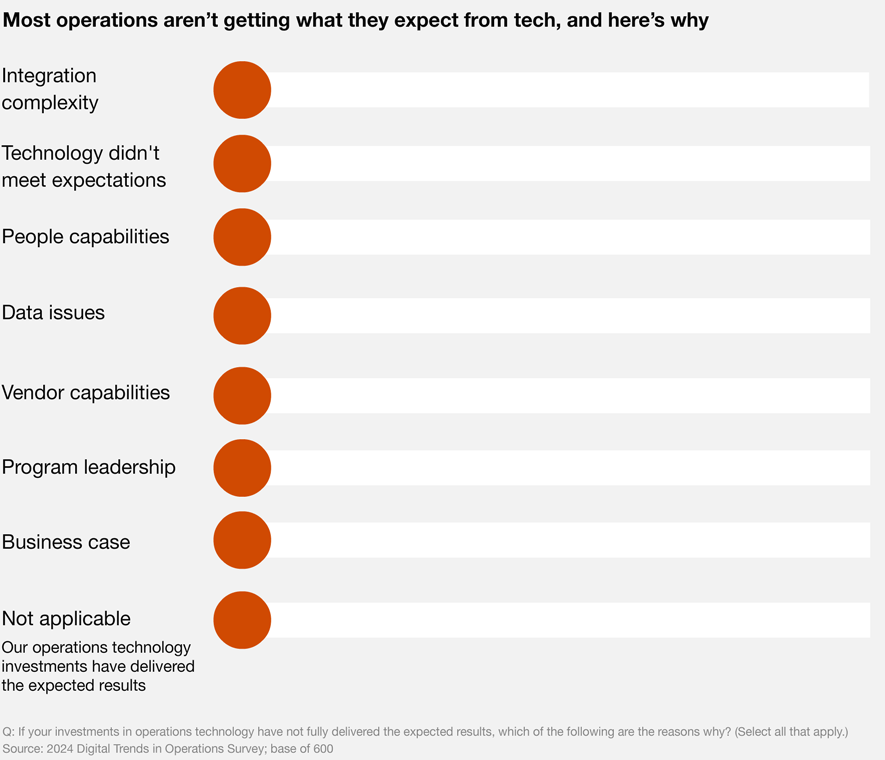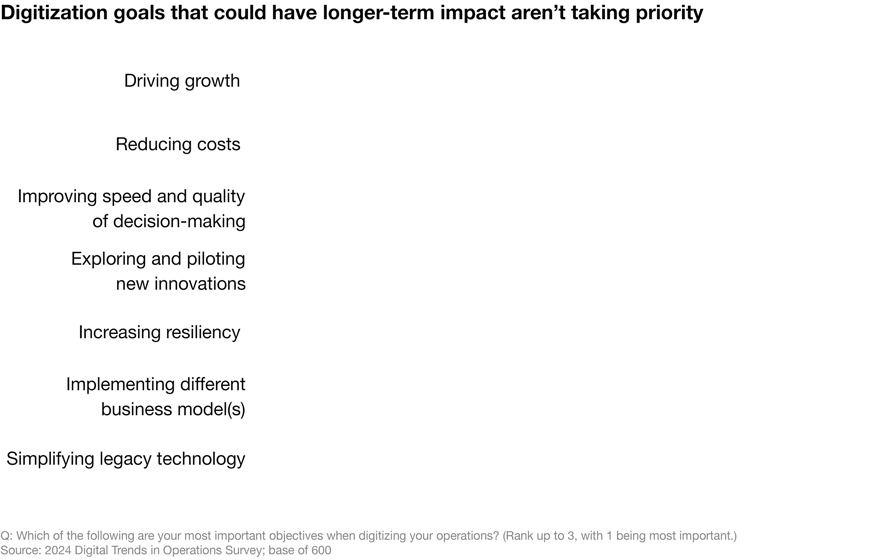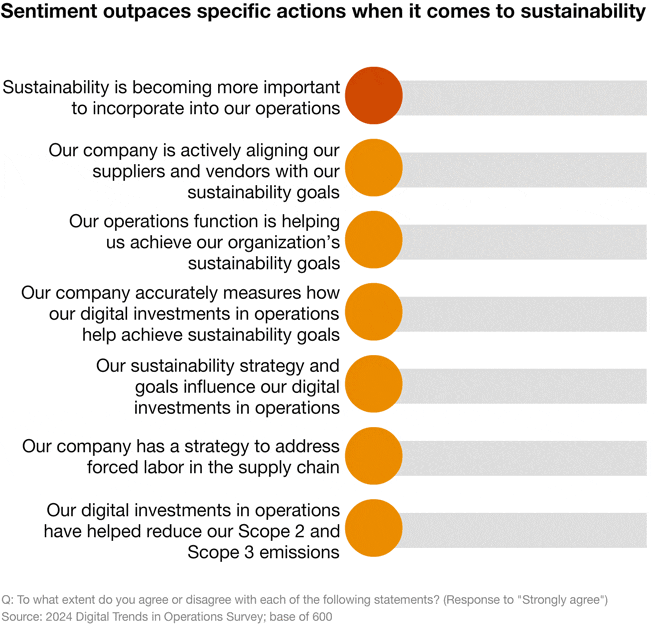{{item.title}}
{{item.text}}

{{item.title}}
{{item.text}}
When companies invest significant dollars in different technologies to improve operations and supply chains, some trial and error is expected. But as our 2024 Digital Trends in Operations Survey shows, there’s still too much error, and that can be a hard pill for the C-suite and shareholders to swallow.
Our survey of 600 operations and supply chain officers found a significant gap between what they expected new technology to deliver and the actual results. For those who are outcomes obsessed, that harms efforts to create more value in the supply chain and operations overall. And that’s something few can afford in a world where 45% of CEOs believe their company won’t be viable in 10 years if it stays on its current path.
Many companies have invested in multiple technologies to digitize operations. Cloud (62%) and AI, including machine learning (55%), are clear leaders, while ERP enhancements (27%) and data ecosystems (33%) see the least investment. Among different areas of operations, quality control uses technology the most, led by AI and operational visibility and analytics. Service and maintenance are seeing the least, and planning, sourcing, manufacturing and distribution are all at a similar level in between.
Even so, 69% of respondents selected at least one reason why their investments in operations technology haven’t fully delivered the expected results. More than half (59%) cited at least two reasons, and 37% cited at least three. While the share of respondents who say their companies didn’t fully realize the expected results is down from previous surveys, the fact that more than two-thirds still claim shortcomings from tech investments indicates a persistent problem.


With GenAI, seven out of 10 survey respondents reported testing or implementation, which aligns with high expectations for the technology. In our 27th Annual Global CEO Survey, 70% of CEOs worldwide said GenAI will significantly change the way their company creates, delivers and captures value.
That said, only one in five operations and supply chain officers said GenAI has been implemented in many areas. And implementation is distributed uniformly across different activities — from training employees on GenAI solutions to hiring new GenAI talent or service providers — indicating a lack of cohesive GenAI strategy in many operations.
Everyone wants to spend less and be more efficient, so it’s understandable that reducing costs and increasing speed are among respondents’ most important objectives when digitizing operations — and continue to be their top priorities overall. But it’s concerning to see much less support for objectives that can have a longer-term impact such as exploring new innovations and implementing different business models.
It’s not just talk, either. While 50% of respondents said they’ve increased their overall technology budget in the last 12 months — which is admirable — only 36% said they’ve restructured their supply chain networks and only 37% said they’ve changed their operating model. In our experience, that “change” is often more enhancement or evolution than a wholesale shift in model. That also meshes with the low response for reconfiguring their supply chain network footprint, with only 26% naming that among top priorities.


Companies have beaten the digital skills drum for years, and 39% of survey respondents said a lack of skilled digital talent is their biggest challenge to digitizing operations — topping data issues, phasing out legacy technology and other challenges. In addition, 74% said talent acquisition and retention are a moderate or major risk to their company’s operations.
But is that just lip service? Consider that less than a third of operations and supply chain leaders say evolving their digital workforce and increasing digitization, automation and analytics are among top priorities. And that comes after executives in our 27th Annual Global CEO Survey said on average that 40% of time spent on meetings, administrative processes and emails is inefficient.
As for executing digital investments in operations, companies are more likely to look within their workforces. More respondents said they’re increasing training for employees on how to use digital technologies (87%), hiring talent with digital skills (84%) and retraining employees for new roles (80%) than changing overall headcount (72%), using third-party vendors to fill skill gaps (64%) and changing their reliance on outsourcing (61%).
If you’re in operations and supply chain, mitigating risk and maneuvering through turbulence are a must. Not surprisingly, supply chain disruptions (46%) and cyber threats and attacks (40%) are the top major risks to a company’s operations, ahead of labor costs, talent acquisition and retention, and high interest rates. And all of these outpace broader global issues that can ripple through operations at companies of many sizes, such as the non-US regulatory environment (21% say a major risk), geopolitical tensions (23%) and climate (25%).
This highlights the need to incorporate resiliency more in long-term planning, yet the shorter-term focus extends to complying with regulations. Many more respondents expect to make new digital investments to comply with cybersecurity and data privacy requirements than to address climate or trade regulations. This suggests that many companies — even if they agree on the need to reorient their supply chain and reconsider their operating model — don’t have the capabilities to think more broadly and radically versus incrementally and “what they know.”
Slightly more than half of operations and supply chain officers strongly agree that incorporating sustainability into operations is becoming more important — a sign that some companies appreciate the strategic opportunities sustainability presents. Those include sustainable products and services, decarbonization across the supply chain and ESG reporting that can lead to insights on growth. As more companies work to align their suppliers with their sustainability goals (as indicated by 45% of respondents strongly agreeing), these suppliers also could make sustainability a higher priority. Companies that take a meaningful approach to sustainability could potentially win new business, gain market share and realize value from digital investments.


It’s time to get serious about how you go beyond chasing a certain technology and actually move the needle with your digital investments — all while remaining outcomes obsessed.
Access an interactive dashboard, filter by industry and more.
Harness new technology, reimagine your business and accelerate outcomes.
PwC’s 2024 Digital Trends in Operations Survey surveyed 600 operations executives and supply chain officers in January and February 2024. Respondents in the online survey included C-suite executives, upper management, directors, managers and board members based in the US who either have sole responsibility for business decisions on operations and supply chain or procurement operations or share influence with others regarding those decisions. Sectors surveyed include consumer markets; energy, utilities and mining; health services and pharmaceuticals; industrial products; and technology and telecommunications.
Explore prior reports: PwC's 2023 Digital Trends in Supply Chain Survey

